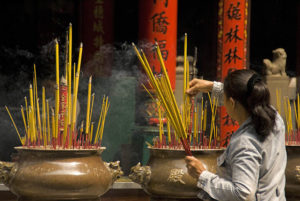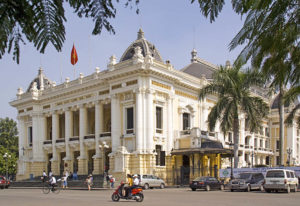Vietnamese cooking class

Thien Hau Pagoda Buddhist Temple in Saigon’s Chinatown. Photo by Dennis Cox/WorldViews
In Part I of Robert Waite’s two-part series on traveling to Vietnam, Vietnam Visit Stirs Emotions for Boomers, Bob recounted his recent visits to Hanoi and Halong Bay.
In this post, he travels to Saigon (Ho Chi Minh City) and the remarkable Cu Chi Tunnel complex dug by the Viet Cong outside the city — but much closer to it than you might imagine.
Saigon itself is a bustling city that evokes stark memories of the Vietnam War, but is also now a prime “foodie” destination and a place to drink at a bar made famous by big-name war correspondents:
By Robert Waite
Part II of a two-part series.
Ho Chi Minh City, Vietnam – The thing about name changes is that they often don’t stick. Take Mumbai, for example. The Indian national government decided that “Bombay” was… Continue reading

Hanoi’s 1911 Opera House is a prime example of the city’s French colonial architecture. Photo by Dennis Cox/WorldViews
In this post and the next, Contributing Writer Robert Waite recounts his recent journey to Vietnam, the country that helped define a generation of baby boomers.
Forty five years after the fall of Saigon, which effectively ended the more-than-a-decade-long Vietnam War, a visit to Hanoi still stirs emotions, whether you were pro- or anti-war in the 1960s and ’70s.
Yet even as long ago as 1997, when I last visited Vietnam, the majority of Vietnamese — born after the war — seemed to hold few if any grudges against Americans.
Our roving correspondent, himself a baby boomer, delves into the war history but also the sights and experiences that make Vietnam one of the most intriguing countries to visit in Southeast Asia today.
First up are the capital, Hanoi, and beautiful Halong… Continue reading
 This is the fifth and final post in guest contributor Myles Stone’s reflections on his recent two-month stay with his family in Hoi An, Viet Nam, more than 40 years after the end of the war that roiled America and in many ways changed baby boomers’ lives and world views forever.
This is the fifth and final post in guest contributor Myles Stone’s reflections on his recent two-month stay with his family in Hoi An, Viet Nam, more than 40 years after the end of the war that roiled America and in many ways changed baby boomers’ lives and world views forever.
But now it’s a new era in this beautiful Southeast Asian country, where the vast majority of the population was born after what they call the American War. (Even when I visited Viet Nam in 1997, there was little anti-American resentment.
Myles offered eloquent observations about the history of the war in his previous post during a visit to the ancient imperial capital of Hue, but now it’s time to move on to one of Viet Nam’s greatest contributions to world culture: its cuisine, which happens to be my own regional favorite.
As usual, this post is illustrated by… Continue reading










